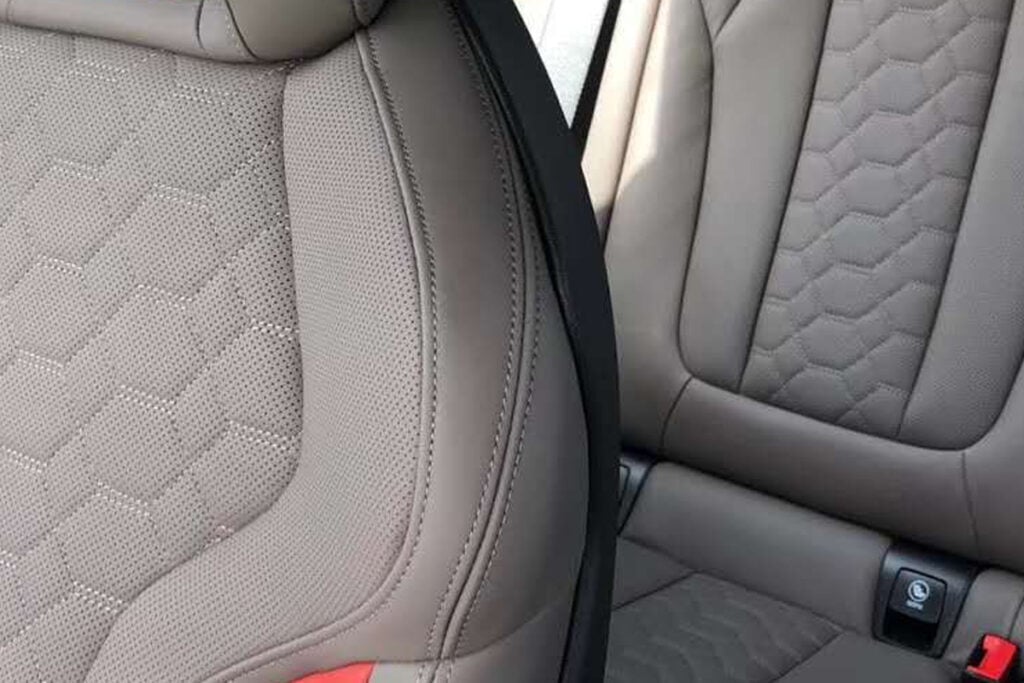In today’s fast-paced society, cars have become indispensable transportation tools. As people pursue higher living standards, they increasingly value car interiors, especially seats. Therefore, automotive sewing thread has gained importance because it improves comfort, enhances style, and strengthens durability.
Table of Contents
What Is Car Seat Stitching?
Automotive sewing thread is a key functional material in automotive interior manufacturing. It is mainly used for stitching seat leather, fabric upholstery, door panels, headliners, and other soft covering layers. Unlike ordinary sewing thread, it must meet dual requirements of functional reliability and visual coordination—not only enduring pulling, friction, and temperature fluctuations during daily use, but also blending seamlessly with interior styling elements such as color and texture. Therefore, manufacturers pay close attention to thread thickness (denier), material (fiber type), and color matching, as these parameters directly affect both durability and premium quality.
Functional Analysis of Automotive Sewing Thread
Structural Support and Decorative Value
The primary role of sewing thread is stitching—precisely joining different materials (such as genuine leather with synthetic leather, or fabric with foam layers) to ensure the structural integrity of seats and door panels. However, its function extends beyond fastening: designers use thread thickness and color contrast (e.g., flat stitch, chain stitch, or backstitch) to create visual effects. For example, dark gray thread on light leather emphasizes seam lines, while contrasting stitches in sports models enhance personality and brand identity, elevating the interior’s atmosphere.
Dual-Safety Processes: Exposed and Hidden Stitches
To balance practicality and aesthetics, manufacturers often use a combination of exposed and hidden stitching techniques:
- Exposed stitching appears along seat edges, armrest contours, or steering wheels, showcasing craftsmanship or sportiness through visible stitches.
- Hidden stitching is common in premium leather-wrapped panels, such as dashboards or door trims. Special techniques conceal stitches inside seams, ensuring strength while preventing friction-related wear.
- Through precise adjustment of these processes, sewing ensures durability under long-term pressure and pulling. By controlling stitch density (typically 8–12 stitches per inch), manufacturers maintain thread tension and prevent cracking from looseness or over-tightness.
Material Selection: Challenges and Solutions
In practice, automotive sewing threads often face three major quality issues: sudden breakage, bottom-thread exposure, and seam fraying. To address these problems, manufacturers prioritize two high-performance materials:
- Polyester Sewing thread (PET): Known for high tensile strength (7–9 g/denier), low shrinkage (resisting deformation under heat), and outstanding chemical resistance (oil, acid, alkali). It is ideal for seats and dashboard areas.
- Nylon Sewing thread (PA6.6): Offers superior elasticity (breaking elongation 30–40%) and abrasion resistance (withstanding over 50,000 friction cycles without damage). It is the preferred choice for high-contact zones such as door panels and seat edges.
Modern sewing threads also receive special surface treatments—such as silicone lubrication layers or polyurethane coatings—to enhance smoothness (reducing machine thread jams) and UV resistance (preventing fading or brittleness under sunlight).
Typical Application Scenarios
Different interior components demand varied thread performance:
- Seats: High-wear zones like cushion edges and headrest joints require abrasion-resistant nylon (typically 600–800D), while comfort zones such as armrest interiors may use softer polyester.
- Door panels and headliners: Exposed to sunlight and humidity, these areas require UV resistance and anti-mildew stability.
- Steering wheels: Threads must combine elasticity (to absorb hand pressure) with smooth surfaces (to avoid leather wear).
- Special functional areas: Child seat threads must pass flame-retardant tests (burning rate ≤100 mm/min), while harnesses near EV battery compartments require heat resistance above 120 °C.

Advantages and Technical Properties of Automotive Sewing Thread
- High Strength and Durability: Nylon 6.6 thread has over three times the strength of cotton thread, while polyester retains stability from –40 °C to 150 °C.
- Smart Process Adaptation: Coating technologies, such as Teflon layers, reduce friction during sewing and prevent skipped or broken stitches.
- Elasticity and Symmetry: High-resilience materials ensure uniform seams (error ≤0.2 mm) that remain stable over time.
- Environmental Resistance: Threads resist acids, alkalis, and stains, ensuring reliability under extreme conditions, including beverage spills or cleaning agent exposure.
Conclusion
Although automotive sewing thread represents only a small fraction of interior cost, it is a critical link between functional safety and design aesthetics. From seat load-bearing to door panel stitching, from visual refinement to tactile comfort, its strength, elasticity, and durability directly shape users’ first impressions of vehicle quality.
As automotive interiors evolve toward luxury and personalization (e.g., Alcantara surfaces, dual-tone designs), sewing threads must advance in both material innovation (e.g., biodegradable fibers, smart color-changing threads) and craft precision (e.g., 0.1 mm stitch accuracy). This evolution reflects not only technological progress but also the industry’s commitment to delivering the ultimate user experience.
